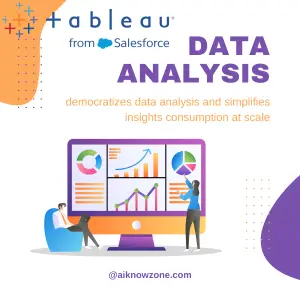Tableau AI
Tableau AI review: democratizing data analysis with AI-powered features. Learn how it works, its pros and cons, and who should use it.
Description
Introduction
Hey everyone! 👋 So, I recently dove headfirst into the world of Tableau AI, and let me tell you, it’s been quite the ride! Tableau AI, for those unfamiliar, is essentially Tableau’s answer to making data analysis easier and more accessible, even for those without extensive data science experience. It aims to democratize data analysis by streamlining the process and making complex insights readily available. What sets it apart from other tools is its seamless integration with the already powerful Tableau platform. You’re not learning a completely new ecosystem; you’re adding a powerful AI layer to one you might already know. It’s like getting a supercharged version of your current workflow.
Key Features and Benefits of Tableau AI
- AI-powered data preparation: This feature automatically cleanses, prepares, and transforms your data, saving you tons of time and effort. No more wrestling with messy spreadsheets! 🧹
- Smart recommendations: Tableau AI suggests relevant visualizations and insights based on your data, which is a game changer for quickly identifying patterns and trends.🤯
- Predictive modeling: It allows you to build and deploy predictive models without needing to be a data scientist. This is seriously cool for forecasting and trend analysis.🔮
- Natural language processing (NLP): You can ask questions in plain English, and Tableau AI will generate the appropriate visualization. This cuts down on the time you spend learning complex syntax.🗣️
- Automated insights: Tableau AI automatically identifies key findings and summarizes them, making it easy to communicate your results to others. This is perfect when you have to report on many things to different kinds of people. 📝
How Tableau AI Works (Simplified)
Firstly, you’ll need a Tableau license (duh!). Next, you’ll connect your data source to Tableau. Once the data is in, Tableau AI really shines. It automatically suggests the best way to prepare your data and will then offer various visualizations. In addition to this, you can start using its NLP feature – simply type your question into the ask data section and Tableau will build and present the answer as a visualization. It’s that simple! Furthermore, you can also create your own predictive models using the built-in tools; it’s surprisingly user-friendly. Overall, the learning curve isn’t too steep, especially if you’re already familiar with Tableau. Consequently, you’ll find yourself creating impressive analyses quite fast.
Real-World Use Cases For Tableau
- Last month, I was helping a local bakery analyze its sales data. Using Tableau AI, I quickly identified the best-selling items and the most profitable days of the week. Moreover, the predictive model helped them forecast demand for the upcoming holidays, allowing them to adjust their inventory accordingly. 🍰📈
- In another instance, I used Tableau AI to analyze customer churn for a SaaS company. The AI-powered insights pinpointed factors contributing to customer churn and, surprisingly, suggested effective strategies to reduce it! This was invaluable in improving customer retention. 👨💼📉
- Furthermore, I used Tableau AI’s predictive analytics to help a marketing team forecast campaign performance. By inputting past campaign data, the AI generated projections of the number of leads, conversions, and return on investment, which helped optimize future campaigns. 🎯
- Finally, I worked with a non-profit to visualize donation trends. Tableau AI’s user-friendly interface made it easy to show the impact of their campaigns and secure additional funding. This highlights how accessible the tool is.
Pros of Tableau AI
- User-friendly interface, even for non-technical users.
- Saves time on data preparation and analysis.
- Provides valuable insights quickly.
- Improves decision-making through data-driven insights.
- Seamlessly integrates with the Tableau platform.
Cons of using Tableau
- It can be expensive, especially for larger organizations.
- Reliance on AI can sometimes limit control over the analysis process.
- Data privacy concerns should be considered.
- The predictive models are good, but don’t expect miracles – they’re only as good as the data you provide.
Tableau Pricing
Tableau’s pricing varies based on the license type and number of users. You’ll need to contact Tableau directly for a personalized quote. However, be prepared for it to not be a cheap option.
Conclusion
Overall, I highly recommend Tableau AI for anyone looking to leverage the power of AI in their data analysis. However, it’s crucial to understand that it’s not a magic bullet. While it simplifies many aspects, it still requires some data literacy. If you’re already a Tableau user or are comfortable learning a new system, this tool can significantly boost your efficiency and data analysis skills. If you’re a data scientist it might feel a little limiting, but for general business analysis it is a very strong tool. So, give it a try! You might just be surprised at what you discover. ✨






Reviews
There are no reviews yet.